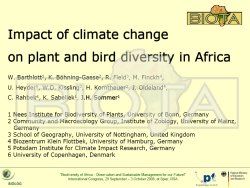|
|
|
 |
|
|
Presentation
< back to presentation overview
| Details of the presentation |
| Presentation |
Oral presentation |
| Title |
Impact of climate change on plant and bird diversity in Africa
|
| PDF Download |
 Download PDF (Filesize 2.3 MB)
Download PDF (Filesize 2.3 MB)

|
| Short title |
Impact of climate change on plant and bird diversity in Africa
|
| Author(s) |
Barthlott, W.(1); Böhning-Gaese, K.(2); Field, R.(3); Finckh, M.(5); Heyder, U.(4); Kissling, W.D.(2); Korntheuer, H.(2); Oldeland, J.(5); Sabellek, K.(1); Sommer, J.H.(1)
|
| Presenting author |
W. Barthlott
|
| Institution(s) |
(1) Nees Institute for Biodiversity of Plants, Rheinische Friedrich-Wilhelms-Universität, D- 53115 Bonn, Germany; (2) Community and Macroecology Group, Department of Ecology, Institute of Zoology, Johannes Gutenberg-University, D-55099 Mainz, Germany; (3) School of Geography, University of Nottingham, NG7 2RD, UK; (4) Potsdam Institute for Climate Impact Research, Telegrafenberg, P. O. Box 601203, D-14412 Potsdam, Germany; (5) Biocentre Klein Flottbek, University of Hamburg, D-22609 Hamburg, Germany
|
| Keywords |
plant diversity, species richness, species distribution models, conservation, continental Africa, animal-plant interactions, macroecology, bioclimatic index
|
| Abstract |
Climate and landuse changes are increasingly threatening Africa's biodiversity. We derived species distributions of plants and birds for continental Africa on the basis of documented distributions and a set of environmental predictor variables. We modelled future distributions of both groups using global climate models. For plants, the vast majority of species ranges decrease markedly in size by 2100. Even if species will be able to invade new geographic regions, a large proportion of climatically suitable habitats may be lost during the next century, especially in dry lowland areas. However, some areas may serve as biodiversity refuges, especially in the tropical wet lowlands and the Afrotropical Mountains. These areas are of particular priority for the setup of sustainable conservation strategies. In a case study for arid mountains in southern Morocco the use of bioclimatic indices suggests severe potential changes in future plant diversity.
For birds, previous models assumed no importance of biotic interactions. Here, we show that inclusion of woody plants in forecasts can change future predictions of bird diversity dramatically. Forecasts on the impact of climate change might be overly optimistic if biotic interactions are not taken into account.
|
| Congress Topic |
Process Analysis
|
| Topic No. |
2.10 |
| Notes |
---
|
| Ref. No. |
537 |
|
|
|
